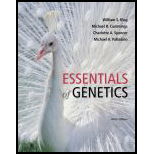
CASE STUDY | Timing is everything
A man in his early 20s received chemotherapy and radiotherapy as treatment every 60 days for Hodgkin disease. After unsuccessful attempts to have children, he had his sperm examined at a fertility clinic, upon which multiple chromosomal irregularities were discovered. When examined within 5 days of a treatment, extra chromosomes were often present or one or more chromosomes were completely absent. However, such irregularities were not observed at day 38 or thereafter.
How might a geneticist explain the time-related differences in chromosomal irregularities?
Case summary:
A male, who suffers from Hodgkin disease receive chemotherapy and radiotherapy treatment every 60 days. His age is in the early 20s and his attempts to have children are unsuccessful. The reason is chromosomal irregularities, which is prominent when he is examined during the first 5 days of treatment.
Characters of the case:
A male patient.
Adequate information:
Hodgkin's disease is a type of cancer which affects lymphatic system and treatment includes radiotherapy and chemotherapy.
To determine:
The time-related chromosomal irregularities during chemotherapy and radiotherapy treatment in a patient suffering from Hodgkin disease.
Explanation of Solution
Given information:
The chromosomal irregularities are not found when examined on or after 38 days of treatment.
The sperm or gamete produced when the person is under treatment is infertile as chemotherapy and radiotherapy can affect healthy cells. The process of meiosis which produces four gametes (sperms) with a haploid number of chromosomes is affected because of high exposure to chemotherapeutic drugs and radiations given during treatment.
Meiosis is the cell division which takes place in germ-line cells which is a layer of undifferentiated cells called spermatogonium present in testes (male reproductive organ). Meiosis produces four haploid gametes or sperms from diploid germ cell which becomes primary spermatocyte to undergo first meiotic division. The product of this division is called secondary spermatocyte which undergoes a second meiotic division to produce spermatids. Spermiogenesis is a specialized process which gives rise to motile sperm with a haploid number of chromosomes.
Sperm produced during the first days of treatment have chromosomal irregularities which include the presence of extra chromosomes or absence of certain chromosomes as the dosage of chemotherapy and radiotherapy affects the germ-line cell division. But at day 38 or thereafter, the dosage level reduces which may not have a direct effect on germ-line cell division. Therefore, chromosomal irregularities are based on the level of exposure to the radiation and chemotherapeutic drugs.
Thus, it can be concluded that the chromosomal irregularities are high during the initial days of treatment as the exposure is high but the level of exposure reduces after 38 days.
Want to see more full solutions like this?
Chapter 2 Solutions
Essentials of Genetics (9th Edition) - Standalone book
- please draw in the answers, thank youarrow_forwarda. On this first grid, assume that the DNA and RNA templates are read left to right. DNA DNA mRNA codon tRNA anticodon polypeptide _strand strand C с A T G A U G C A TRP b. Now do this AGAIN assuming that the DNA and RNA templates are read right to left. DNA DNA strand strand C mRNA codon tRNA anticodon polypeptide 0 A T G A U G с A TRParrow_forwardplease answer all question below with the following answer choice, thank you!arrow_forward
- please draw in the answeres, thank youarrow_forwardA) What is being shown here?B) What is indicated by the RED arrow?C) What is indicated by the BLUE arrow?arrow_forwardPlease identify the curve shown below. What does this curve represent? Please identify A, B, C, D, and E (the orange oval). What is occurring in these regions?arrow_forward
- Please identify the test shown here. 1) What is the test? 2) What does the test indicate? How is it performed? What is CX? 3) Why might the test be performed in a clinical setting? GEN CZ CX CPZ PTZ CACarrow_forwardDetermine how much ATP would a cell produce when using fermentation of a 50 mM glucose solution?arrow_forwardDetermine how much ATP would a cell produce when using aerobic respiration of a 7 mM glucose solution?arrow_forward
- Determine how much ATP would a cell produce when using aerobic respiration to degrade one small protein molecule into 12 molecules of malic acid, how many ATP would that cell make? Malic acid is an intermediate in the Krebs cycle. Assume there is no other carbon source and no acetyl-CoA.arrow_forwardIdentify each of the major endocrine glandsarrow_forwardCome up with a few questions and answers for umbrella species, keystone species, redunant species, and aquatic keystone speciesarrow_forward
 Human Heredity: Principles and Issues (MindTap Co...BiologyISBN:9781305251052Author:Michael CummingsPublisher:Cengage Learning
Human Heredity: Principles and Issues (MindTap Co...BiologyISBN:9781305251052Author:Michael CummingsPublisher:Cengage Learning Biology: The Dynamic Science (MindTap Course List)BiologyISBN:9781305389892Author:Peter J. Russell, Paul E. Hertz, Beverly McMillanPublisher:Cengage Learning
Biology: The Dynamic Science (MindTap Course List)BiologyISBN:9781305389892Author:Peter J. Russell, Paul E. Hertz, Beverly McMillanPublisher:Cengage Learning Biology: The Unity and Diversity of Life (MindTap...BiologyISBN:9781337408332Author:Cecie Starr, Ralph Taggart, Christine Evers, Lisa StarrPublisher:Cengage Learning
Biology: The Unity and Diversity of Life (MindTap...BiologyISBN:9781337408332Author:Cecie Starr, Ralph Taggart, Christine Evers, Lisa StarrPublisher:Cengage Learning Biology: The Unity and Diversity of Life (MindTap...BiologyISBN:9781305073951Author:Cecie Starr, Ralph Taggart, Christine Evers, Lisa StarrPublisher:Cengage Learning
Biology: The Unity and Diversity of Life (MindTap...BiologyISBN:9781305073951Author:Cecie Starr, Ralph Taggart, Christine Evers, Lisa StarrPublisher:Cengage Learning Biology 2eBiologyISBN:9781947172517Author:Matthew Douglas, Jung Choi, Mary Ann ClarkPublisher:OpenStax
Biology 2eBiologyISBN:9781947172517Author:Matthew Douglas, Jung Choi, Mary Ann ClarkPublisher:OpenStax Anatomy & PhysiologyBiologyISBN:9781938168130Author:Kelly A. Young, James A. Wise, Peter DeSaix, Dean H. Kruse, Brandon Poe, Eddie Johnson, Jody E. Johnson, Oksana Korol, J. Gordon Betts, Mark WomblePublisher:OpenStax College
Anatomy & PhysiologyBiologyISBN:9781938168130Author:Kelly A. Young, James A. Wise, Peter DeSaix, Dean H. Kruse, Brandon Poe, Eddie Johnson, Jody E. Johnson, Oksana Korol, J. Gordon Betts, Mark WomblePublisher:OpenStax College





